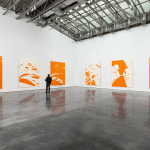This iteration of “Greater New York,” the sprawling group exhibition at MoMA PS1 that traditionally highlights the most prominent young artists working in the last five years, features an epoch-spanning roster and includes work not just made in the last twenty minutes, but work made in the 1960s, 1970s, and 1980s. Is the curatorial team challenging younger artists to start making more interesting work, work that means something, rather than making safe work that attracts collectors?
In the NYTimes Roberta Smith writes that there are plenty of abstract paintings in the show, but that formal concerns are not the primary focus:
�Greater New York,� now in its fourth edition, has its share of abstract painting, but cannily weaves it into a larger story, one that goes beyond a fixation on form to focus on ideas that tie art and artists to life. With a multigenerational team of organizers � Peter Eleey and Mia Locks of P.S. 1; Thomas J. Lax, associate curator of media and performance art at MoMA; and Douglas Crimp, a professor of art history at the University of Rochester � the show steps away from its founding premise of newness, the idea that it would be a quinquennial update on the metropolitan market. The 158 artists on the roster range from 20-something to 80-something; a few are dead. The notion that an �emerging� artist has to be young is discarded. Older artists newly in the spotlight, or back after a long delay, qualify. And history works in two directions. Art from the 1970s and �80s is presented as prescient of what�s being made now, and new art is viewed as putting a trenchant spin on the past.
In the Village Voice Jessica Dawson suggests that young artists aren’t making enough good work to fill the space:
What we might infer from Eleey’s statement is a fact many of us already know: that the field of rigorous, exceptional, youngish artists (the field “Greater New York” serves) is thin � too sparse, perhaps, to fill a single exhibition at MoMA P.S.1 � even as an overabundance of derivative work sells briskly in the marketplace. And so perhaps to add a bit of context for the young’uns, and to give us something to chew on, half of the 158-artist pool of this “Greater New York” is over age 40, and many are well-known and by no means emerging. The team even invited Douglas Crimp, an actual middle-aged person who circulated in this city’s art world for much of his adult life and is now writing a memoir of that Arcadian era, to help curate.
At ArtNews, Andrew Russeth deems the show a qualified success:
If the goal of �Greater New York� is to provide for the layperson an overview of what the youth and some of their more esteemed elders are up to, then this edition is reasonably successful. It presents a multifarious art scene that is hot for painting (at least of the studiedly na�ve, digitally pristine, or scatological varieties), taken with outr�minded fashion designers, returning to the readymade in oblique ways, and occasionally a bit too enamored of the past…. This is a show about visual pleasures, albeit of a largely restrained, domesticated kind…. Walking through the show, I kept hoping to come upon more signs of the tense, tenuous state of the city in 2015, displays of biting dissonance. They never appeared. On the one hand, I admire the sunny disposition of so much here; on the other, I admit that it feels off.
My recommendation: If you want to find out what’s going on in artists’ studios right now, this isn’t the show to see. But if you love New York and its rich history of artists and art communities, there’s a lot to like, particularly documentary images of Gordon Matta-Clark�s Doors Through and Through (1976), Alvin Baltrop‘s photographs from the 1970s, and Pendulum (1976), James Nares�s poignant film of a wrecking ball in Soho. Another highlight is the huge, naturally lit space on the second floor dedicated to human-scale figurative sculpture. I’ve been saying for a few years that handmade sculptural objects are going to make a comeback, and it looks like their moment has finally arrived.
Supporting the curators’ statement that “Greater New York” is “emphatically representing the city�s inhabitants through forms of bold figuration,” most paintings in the show have a figurative component. That said, besides the inspired inclusion of Gina Beavers and Mira Dancy and the timely salutes to Robert Bordo and Robert Kushner, the selection seems somewhat random. Here are some images of the paintings (and painted objects) included:
Sadie Benning (b. 1973), Spider, 2015.
Yoshiaki Mochizuki (b. 1961), Untitled, 2015.
Gedi Seboni (b. 1973) (Image via Andrew Russeth and ArtNews)
——
Two Coats of Paint is licensed under a Creative Commons Attribution – Noncommercial-No Derivative Works 3.0 United States License. To use content beyond the scope of this license, permission is required.









































greg parma smith was born in 1983 – not 1945
Thanks Anon. The date has been corrected.
S.